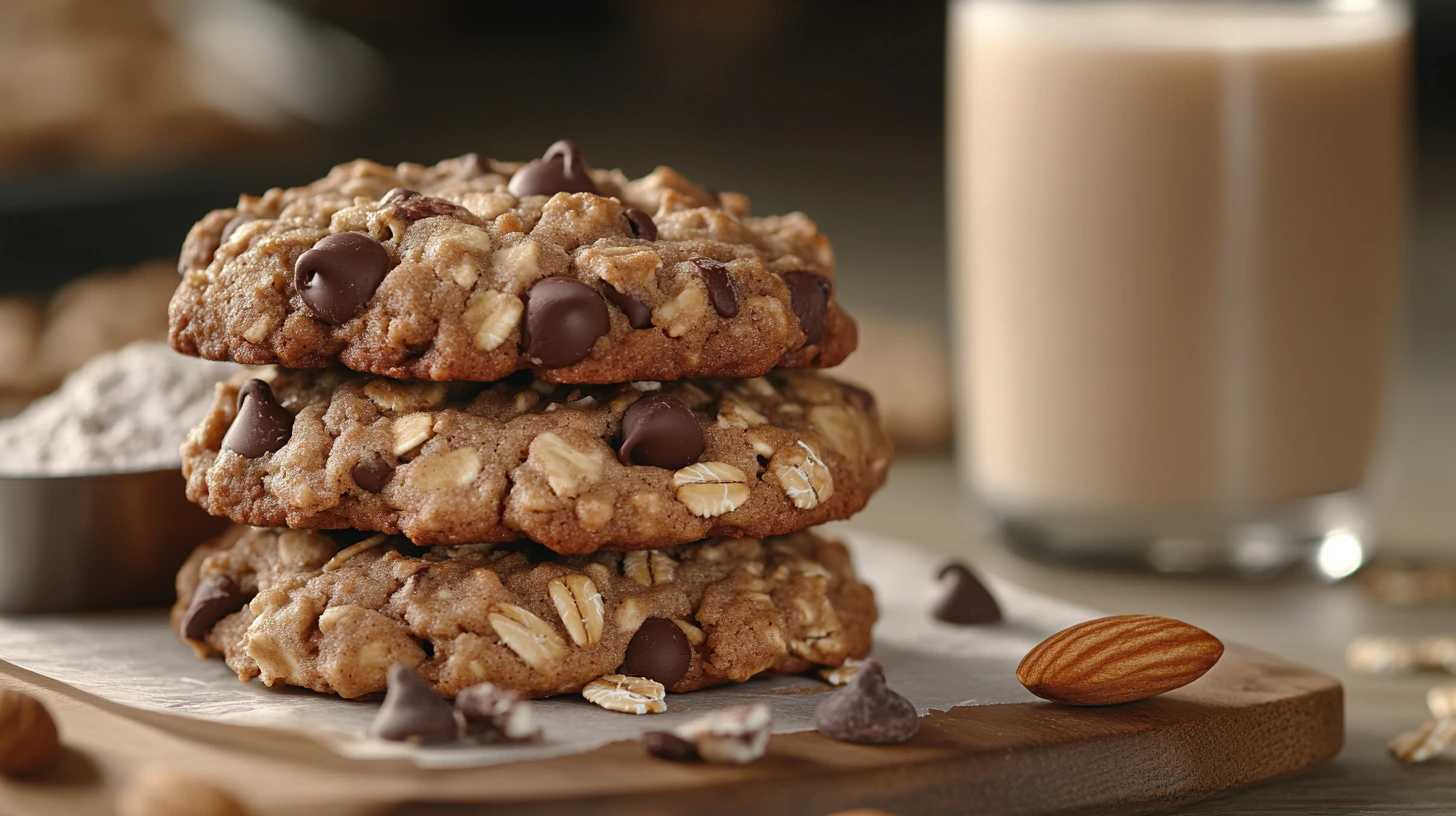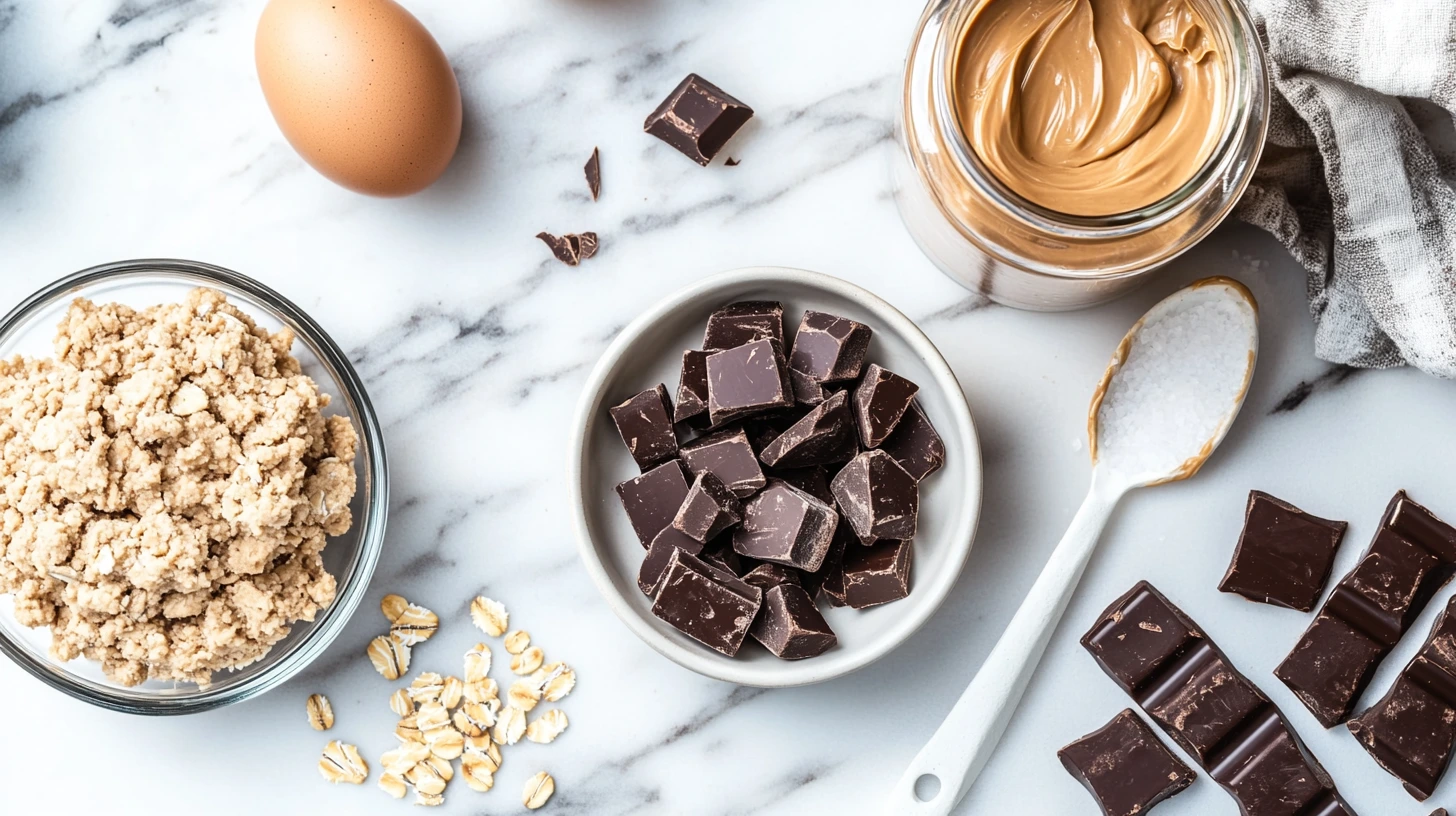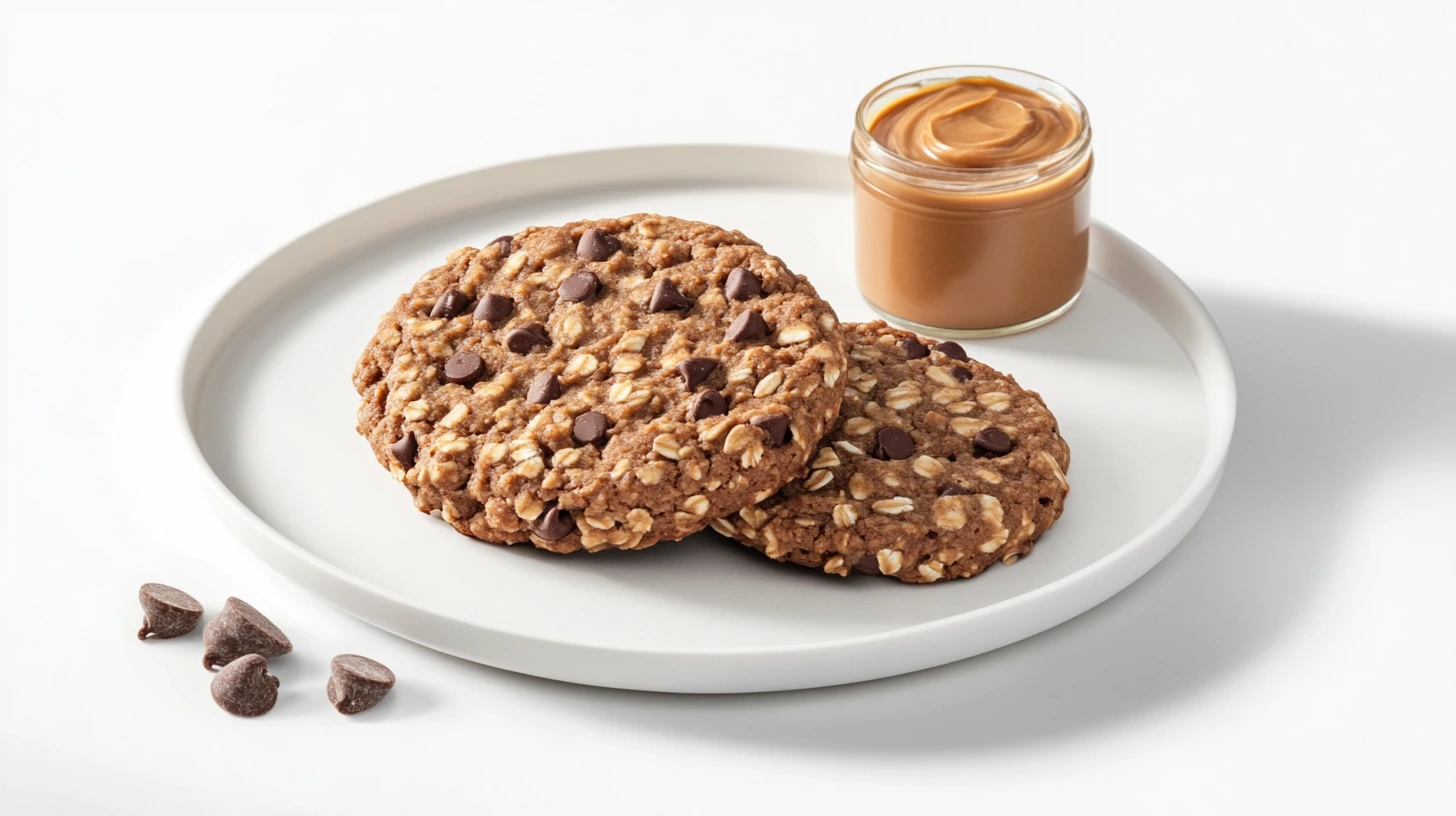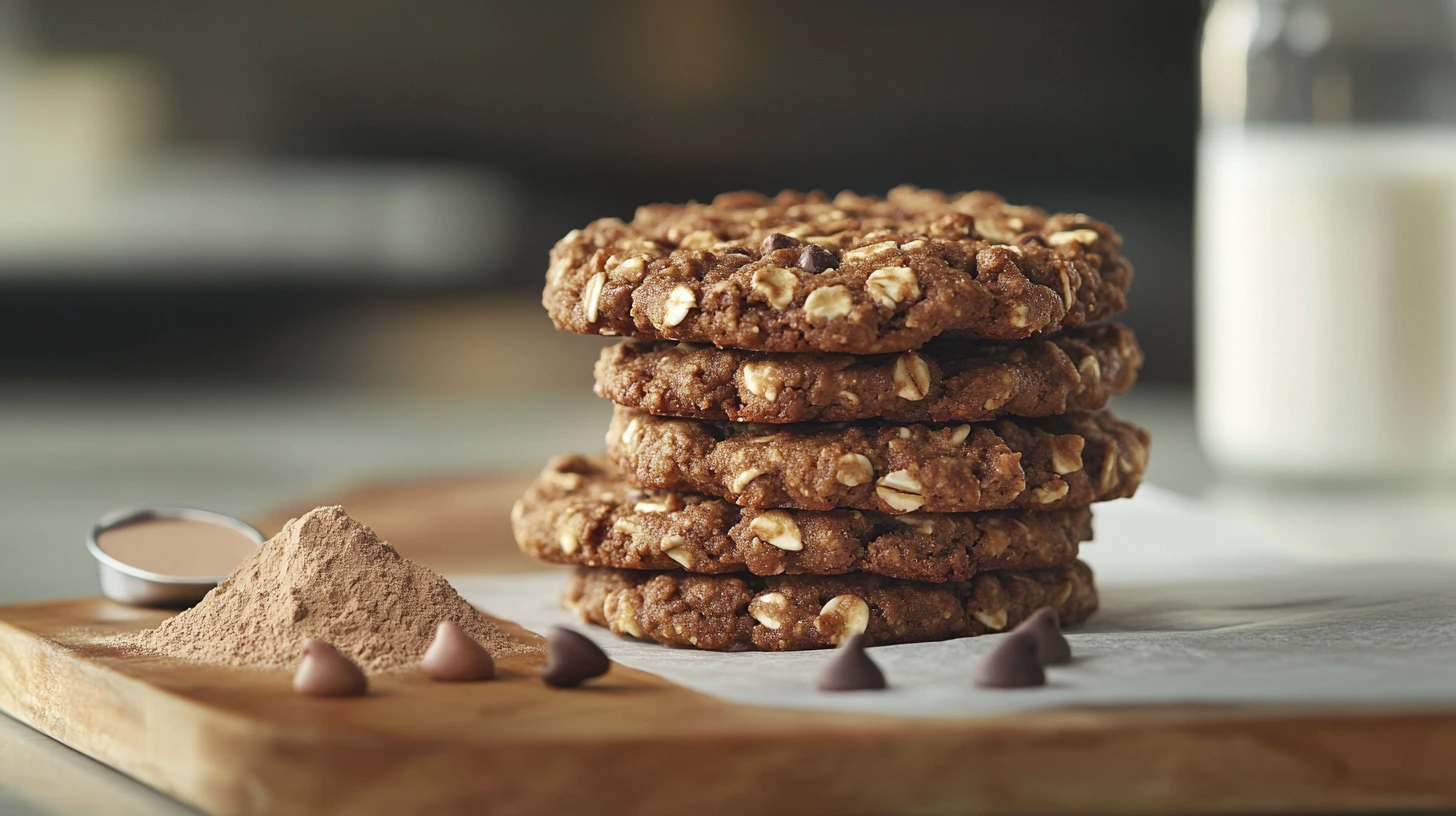
Table of Contents
Introduction to Protein Cookie Recipe
What Are Protein Cookie Recipe?
Protein cookie recipe are a delicious, nutrient-packed alternative to traditional cookies. These treats are made with protein-rich ingredients like whey protein powder, almond flour, peanut butter, or oats and are designed to satisfy cravings while supporting your nutritional goals. Whether enjoyed as a post-workout snack, a quick breakfast, or a healthier dessert, protein cookies offer the best of both worlds: taste and nutrition.
Benefits of Incorporating Protein Cookies into Your Diet
- Boosts Protein Intake: Protein cookies help you meet your daily protein requirements, essential for muscle repair, energy, and overall health.
- Keeps You Fuller Longer: The high protein helps curb hunger and reduce snacking on less nutritious foods.
- Convenient and Portable: They’re perfect for on-the-go lifestyles, offering a satisfying snack option that’s easy to carry.
- Supports Fitness Goals: Protein cookies can help muscle recovery and maintain energy levels after workouts.
- Lower in Sugar: Many recipes use natural sweeteners or reduced sugar, making them healthier for those watching their sugar intake.
Why This Recipe Is Perfect for Fitness Enthusiasts and Snack Lovers Alike
This protein cookie recipe strikes the perfect balance between nutrition and flavor. It’s simple to prepare and customizable, allowing you to add your favorite ingredients like chocolate chips, nuts, or dried fruits. Ideal for fitness enthusiasts looking to fuel their workouts or snack lovers craving a guilt-free treat, these cookies are a versatile and wholesome addition to your diet.
Key Ingredients for Protein Cookie Recipe
- Protein Powders: Whey, Plant-Based, or Casein
Protein powder is the star ingredient in protein cookies, providing the essential protein boost:
- Whey Protein: A fast-digesting option that mixes well with other ingredients and adds a creamy texture to cookies. Ideal for post-workout snacks.
- Plant-Based Protein: Made from sources like peas, rice, or hemp, these are great for vegans or those with dairy sensitivities. They create a slightly denser texture.
- Casein Protein: A slow-digesting protein that retains moisture, making cookies softer and chewier. It’s excellent for a nighttime snack to keep you fuller longer.
- Nut Butter and Their Nutritional Benefits
Nut butters not only enhance the flavor and texture of protein cookies but also add healthy fats and nutrients:
- Peanut Butter: Rich in protein, healthy fats, and vitamins like B3 and E. Its creamy texture makes it a popular choice.
- Almond Butter: A great vitamin E, magnesium, and calcium source. It has a slightly sweet, nutty flavor.
- Cashew Butter is a milder buttery alternative that blends well with various flavor profiles.
- Sunflower Seed Butter: A nut-free option high in healthy fats and vitamin E, perfect for those with allergies.
- Natural Sweeteners: Honey, Maple Syrup, or Stevia
For a touch of sweetness without refined sugars, these natural alternatives are ideal:
- Honey: Provides a rich flavor, natural sweetness, and a boost of antioxidants.
- Maple Syrup: Adds a deep, caramel-like sweetness and is a good source of minerals like manganese.
- Stevia: A calorie-free sweetener derived from the stevia plant. It’s ideal for those on low-sugar or keto diets, though it should be used sparingly to avoid bitterness.
Other Supporting Ingredients
- Oats: Add fiber and create a chewy texture.
- Coconut Flour or Almond Flour: Great gluten-free options complement the protein powder and moisten the cookies.
- Mix-Ins: Dark chocolate chips, nuts, seeds, or dried fruits can be added for flavor and texture variety.
Easy Protein Cookie Recipe

Ingredients
- 1 cup oat flour (or ground oats)
- One scoop of protein powder (whey, plant-based, or your choice)
- ½ cup nut butter (peanut, almond, or sunflower seed butter)
- ¼ cup honey or maple syrup (or stevia for a lower-calorie option)
- One large egg (or flaxseed egg for vegans)
- 1 tsp vanilla extract
- ¼ tsp baking powder
- ¼ cup dark chocolate chips or your choice of mix-ins (optional)
Instructions
- Preheat Oven: Preheat your oven to 350°F (175°C) and line a baking sheet with parchment paper.
- Mix Dry Ingredients: Combine the oat flour, protein powder, and baking powder in a large bowl. Stir until evenly mixed.
- Add Wet Ingredients: Add the nut butter, honey or maple syrup, egg, and vanilla extract to the bowl. Stir until a thick dough forms. If the dough is too dry, add almond milk or water.
- Fold in Mix-Ins: Gently fold in chocolate chips, nuts, or other desired mix-ins.
- Shape the Cookies: Scoop 1–2 tablespoons of dough and roll it into a ball. Flatten slightly and place on the prepared baking sheet. Repeat with the remaining dough, spacing cookies about 2 inches apart.
- Bake: Bake for 8–10 minutes or until the edges are slightly golden. Be careful not to overbake, as protein cookies can become dry.
- Cool and Enjoy: Let the cookies cool on the baking sheet for 5 minutes before transferring them to a wire rack to cool completely.
Step-by-Step Guide to Making Protein Cookie Recipe
- Prepping Your Ingredients and Workspace
- Gather Ingredients: Measure all the necessary ingredients, including protein powder, flour, nut butter, sweetener, eggs, and mix-ins like chocolate chips or nuts. Having everything ready ensures a smooth process.
- Prepare Your Equipment: Preheat your oven to 350°F (175°C) and line a baking sheet with parchment paper to prevent sticking and make cleanup easier.
- Organize Your Tools: You’ll need a large mixing bowl, a spatula or wooden spoon, and a measuring spoon for shaping the cookies.
- Mixing Wet and Dry Ingredients
- Combine Dry Ingredients: In a large bowl, whisk together the dry ingredients such as oat flour, protein powder, and baking powder. This ensures even distribution and prevents clumps.
- Mix Wet Ingredients: In a separate bowl, combine the nut butter, honey or maple syrup, egg, and vanilla extract. Whisk until smooth and creamy.
- Incorporate Wet and Dry: Gradually pour the wet mixture into the dry ingredients. Stir gently with a spatula or wooden spoon until a thick, dough-like consistency forms. If the dough is too dry, add a small almond milk or water splash until it holds together.
- Add Mix-Ins: Fold in your chosen mix-ins, such as chocolate chips, nuts, or dried fruit, for extra flavor and texture.
- Forming and Baking Your Cookies
- Shape the Dough: Use a tablespoon or small scoop to portion the dough. Roll it into balls and flatten it slightly with your hands or a fork to form cookie shapes. Place them on the prepared baking sheet, leaving about 2 inches of space between each cookie.
- Bake the Cookies: Place the baking sheet in the oven and bake for 8–10 minutes or until the edges are lightly golden. Avoid overbaking to keep the cookies soft and chewy.
- Cool and Enjoy: Remove the cookies from the oven and let them cool on the baking sheet for 5 minutes. Transfer them to a wire rack to cool completely before storing or serving.
Bonus Tips
- Storage: You can store your protein cookies in an airtight container at room temperature for up to 5 days or refrigerate them for up to 2 weeks.
- Freezing: Freeze baked cookies for up to 3 months for a ready-to-eat snack anytime.
Customizing Your Protein Cookie Recipe

Gluten-Free Options
If you need to make your protein cookie Recipe gluten-free, here are some simple adjustments:
- Flour Substitutes: Replace oat flour with certified gluten-free oat flour, almond flour, or coconut flour. Note that coconut flour absorbs more liquid, so use it sparingly (about ¼ of the other flour).
- Protein Powder: Ensure your protein powder is labeled gluten-free. Many plant-based and whey proteins meet this requirement.
- Mix-Ins: Choose gluten-free add-ins like chocolate chips, nuts, or seeds.
Vegan-Friendly Substitutions
For a vegan version of protein cookie recipe, use these alternatives:
- Egg Replacement: Use a flaxseed egg (1 tablespoon flaxseed meal mixed with three tablespoons water, set for 5 minutes) or unsweetened applesauce (¼ cup per egg).
- Protein Powder: Opt for plant-based protein powders like pea, rice, or hemp protein.
- Sweetener: Choose maple syrup or agave nectar instead of honey.
- Mix-Ins: Use vegan-friendly chocolate chips or dried fruits for added flavor.
Lower-Calorie Variations
To reduce calories while keeping the cookies delicious and satisfying:
- Nut Butter: Swap regular nut butter with powdered peanut butter mixed with water for a lower-calorie option.
- Sweeteners: Use calorie-free sweeteners like stevia, monk fruit, or erythritol instead of honey or maple syrup.
- Chocolate Chips: To reduce sugar and calories, replace regular chocolate chips with mini dark chocolate chips or sugar-free options.
- Portion Control: Make smaller cookies to reduce calories per serving naturally.
Recipe Example: Vegan & Gluten-Free Protein Cookie Recipe
Ingredients:
- 1 cup almond flour
- One scoop of plant-based protein powder
- One flaxseed egg (1 tbsp flaxseed meal + 3 tbsp water)
- ¼ cup almond butter
- 2 tbsp maple syrup
- 1 tsp vanilla extract
- ¼ cup vegan chocolate chips
Instructions:
- Preheat oven to 350°F (175°C) and line a baking sheet with parchment paper.
- Mix dry ingredients in one bowl and wet ingredients in another.
- Combine both mixtures and stir in chocolate chips.
- Shape dough into cookies and bake for 8–10 minutes.
Nutritional Benefits of Homemade Protein Cookie Recipe
Calorie and Macronutrient Breakdown
Homemade protein cookies can be tailored to your nutritional needs, but a typical cookie made with wholesome ingredients has the following approximate values per serving:
- Calories: 120–150 per cookie
- Protein: 8–12 grams (depending on the type and amount of protein powder used)
- Carbohydrates: 10–15 grams (primarily from oats, honey, or mix-ins like fruit)
- Fats: 5–8 grams (from nut butter or seeds)
These cookies balance energy, muscle-repairing protein, and satiating fats, making them an ideal snack for active individuals or anyone seeking a healthier alternative to traditional cookies.
Comparing Homemade vs. Store-Bought Options
Homemade protein cookies offer several advantages over store-bought versions:
- Customizable Ingredients: You control the type and quality of ingredients, avoiding unnecessary additives, preservatives, and excessive sugar.
- Lower Sugar Content: Many store-bought protein cookies contain hidden sugars, while homemade options can use natural sweeteners like honey or stevia.
- Cost-Effective: Making cookies at home is often more economical than buying pre-packaged ones.
- Freshness and Flavor: Homemade cookies are fresher and can be tailored to your taste preferences with different flavors and textures.
How to Tailor Cookies for Specific Dietary Goals
- For Muscle Gain:
- Add an extra scoop of protein powder for more protein per cookie.
- Use calorie-dense ingredients like peanut butter or dark chocolate to increase overall calories.
- For Weight Loss:
- Opt for low-calorie sweeteners like stevia or monk fruit instead of honey or maple syrup.
- Use powdered peanut butter instead of full-fat nut butter.
- Stick to smaller portions or reduce mix-ins like chocolate chips to lower calories.
- For Low-Carb or Keto Diets:
- Replace oat or almond flour with coconut flour to reduce carbs.
- Use erythritol or monk fruit as sweeteners.
- Incorporate high-fat ingredients like coconut oil or heavy cream for a keto-friendly profile.
- For Energy Boosting:
- Add mix-ins like chia seeds, flaxseeds, or dried fruits to boost fiber and natural energy.
Protein Cookie Recipe for Different Dietary Needs

Low-Carb Protein Cookie Recipe
Features: These cookies reduce carbohydrate content while maintaining a good amount of protein.
Key Ingredients:
- Coconut flour or almond flour instead of oat flour.
- Stevia, erythritol, or monk fruit as a sugar alternative.
- Mix-ins like unsweetened shredded coconut or seeds for added texture.
Example Recipe:
- Ingredients: 1 scoop whey protein, ¼ cup coconut flour, 1 egg, two tablespoons almond butter, two tablespoons erythritol, ¼ tablespoons baking powder.
- Instructions: Mix all ingredients, shape into cookies, and bake at 350°F (175°C) for 8–10 minutes.
Keto-Friendly Options
Features: It is high in healthy fats, moderate in protein, and very low in carbohydrates, making it suitable for keto diets.
Key Ingredients:
- Almond flour or a combination of almond and coconut flour.
- High-fat ingredients like cream cheese, coconut oil, or butter.
- Sugar-free chocolate chips or keto-friendly mix-ins like nuts or seeds.
Example Recipe:
- Ingredients: 1 cup almond flour, 1 scoop keto-friendly protein powder, 2 tablespoons coconut oil, two tablespoons erythritol, one teaspoon vanilla extract, ¼ cup sugar-free chocolate chips.
- Instructions: Mix ingredients, shape into cookies, and bake at 350°F (175°C) for 10 minutes.
Dairy-Free and Nut-Free Recipes
Features: Safe for those with dairy or nut allergies, using alternative flour and butter.
Key Ingredients:
- Use sunflower seed butter or tahini instead of nut butter.
- Replace whey protein with a plant-based, dairy-free protein powder.
- Coconut milk or water as a liquid alternative.
Example Recipe:
- Ingredients: 1 cup sunflower seed butter, 1 scoop plant-based protein powder, ¼ cup coconut sugar, 1 egg (or flaxseed egg), 1 tsp vanilla extract.
- Instructions: Combine ingredients, shape into cookies, and bake at 350°F (175°C) for 10–12 minutes.
Frequently Asked Questions About Protein Cookie Recipe
Can I Bake Protein Cookies Without Protein Powder?
Yes, you can make protein cookies without protein powder by using alternative protein-rich ingredients:
- Nut Butter: Peanut butter, almond butter, or sunflower seed butter add protein and a creamy texture.
- Oats: Ground oats or whole oats contribute protein and fiber.
- Greek Yogurt: Adds moisture and a protein boost. Use in combination with flour for a balanced texture.
- Legume Flours: Chickpea or lentil flour are protein-rich and works well in cookie recipes.
Adjust the proportions of dry and wet ingredients to maintain consistency.
What’s the Best Protein Powder for Baking?
The best protein powder depends on your dietary needs and preferences:
- Whey Protein: A popular choice for its smooth texture and ability to blend well. It works perfectly in cookies for a soft and chewy result.
- Plant-Based Protein: Made from sources like peas, rice, or hemp, it’s ideal for vegans and those with dairy sensitivities. However, it can produce denser cookies, so pair it with moist ingredients like applesauce or banana.
- Casein Protein: Retains moisture better than whey, resulting in softer, more tender cookies.
- Keto or Low-Carb Powders: Look for blends with minimal carbs and sugar, especially for keto-friendly cookies.
Choose unflavored or vanilla-flavored powders for versatile use, and always consider the taste of the powder when adding it to recipes.
How Do I Make Protein Cookies Softer?
To ensure soft and chewy protein cookies, try the following tips:
- Avoid Overbaking: Protein cookies bake faster than traditional cookies. Remove them from the oven when the edges are set, and let them cool on the baking sheet.
- Add Moisture: Incorporate ingredients like Greek yogurt, applesauce, mashed banana, or coconut oil to keep the dough moist.
- Use Casein Protein Powder: Casein protein retains moisture better than whey, resulting in a softer texture.
- Chill the Dough: Refrigerate the dough for 15–30 minutes before baking to prevent spreading and help the cookies retain a tender crumb.
- Store Properly: Keep cookies in an airtight container to prevent them from drying out. Add a slice of bread to the container to maintain moisture if needed.
Conclusion: Why Protein Cookie Recipe Are a Game-Changer
Recap of Their Benefits and Versatility
Protein cookies are more than just a snack—they’re a delicious, nutrient-packed solution for satisfying cravings while supporting your health and fitness goals. With their high protein content, customizable ingredients, and ability to cater to various dietary needs, these cookies offer the perfect balance of flavor and nutrition. Whether fueling a workout, looking for a quick energy boost, or enjoying a guilt-free dessert, protein cookies are an incredibly versatile option.
Encouragement to Experiment with the Recipe at Home
The beauty of protein cookies lies in their adaptability. From low-carb to vegan-friendly options, you can experiment with different flours, sweeteners, and mix-ins to create a recipe that suits your taste and lifestyle. Whether you’re a fitness enthusiast or love trying new recipes, protein cookies are a fun and rewarding baking project.
So, grab your favorite protein powder, preheat your oven, and get creative in the kitchen! Once you’ve tasted the results, you’ll see why protein cookies are a game-changer.
Try this recipe tonight and tag us @biscsweet on social media and follow us on Facebook.
